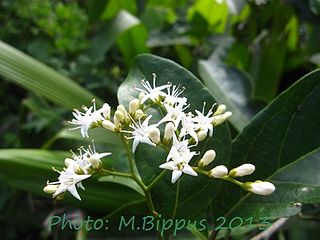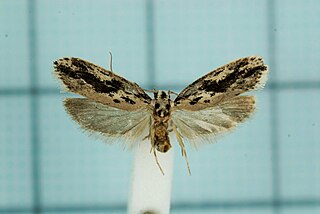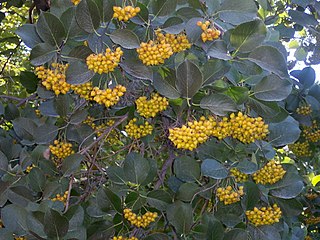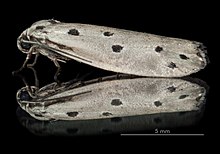
Ehretia acuminata is a deciduous tree found in Japan, China, Bhutan, Nepal, Laos, Vietnam, New Guinea and Australia. Fossil evidence suggests an ancient Laurasian origin. This group of plants spread to Australia and South America via Africa, when these continents were still joined.

Ehretia is a genus of flowering plants in the borage family, Boraginaceae. It contains 66 species native to the tropics and subtropics of the Americas, sub-Saharan Africa, Asia, Papuasia, and Australia. The generic name honors German botanical illustrator Georg Dionysius Ehret (1708–1770).

Ethmia nigroapicella, commonly known as the kou leafworm, is a moth of the family Depressariidae. It is found in Madagascar, the Seychelles, India, Assam, Burma, Samoa, the Philippines, Hawaii, Taiwan, Japan and Australia.

Ehretia anacua is medium-sized tree found in eastern Mexico and southern Texas in the United States. It is a member of the borage family, Boraginaceae. One of its common names, anacua, is derived from the Mexican Spanish word anacahuite, as is that of the related Cordia boissieri, the anacahuita. That word in turn is derived from the Nahuatl words āmatl, meaning "paper," and cuahuitl, meaning "tree," possibly referring to the bark. It is also known as knockaway, a corruption of anacua, and sandpaper tree. Alternate spellings are anaqua and anachua.

Dialectica ehretiae is a moth of the family Gracillariidae. It is known from South Africa and Ethiopia.
Dialectica geometra is a moth of the family Gracillariidae. It is known from Hong Kong, Japan, India and Réunion. It has recently been recorded from China.

Ehretia microphylla, synonym Carmona retusa, also known as the Fukien tea tree or Philippine tea tree, is a species of flowering plant in the borage family, Boraginaceae.

Ethmia pseudozygospila is a moth in the family Depressariidae. It is found in China and Taiwan.

Ethmia lineatonotella is a moth in the family Depressariidae. It is found in India, Myanmar, Vietnam, China and Taiwan.

Ethmia epitrocha is a moth in the family Depressariidae. It is found in Japan, China, and Taiwan.

Ethmia maculata is a moth in the family Depressariidae. It is found in China and Taiwan.
Ethmia maculifera is a moth in the family Depressariidae. It is found in Japan and Taiwan.

Ethmia lapidella is a moth in the family Depressariidae. It is found in India, Japan, China and Taiwan.
Ethmia assamensis is a moth in the family Depressariidae. It is found in India, China, Pakistan, Sri Lanka, Bhutan and Nepal. Records for Taiwan are based on misidentifications of Ethmia okinawana.

Ehretia saligna, commonly known as peach bush, native willow and peachwood is a species of shrubs or small trees, endemic to Northern Australia. The natural range extends from the Gascoyne, across the Northern Territory throughout northern Queensland and coastal; regions of Southern Queensland and New South Wales.

Ehretia dicksonii is a tree that is native to Asia and cultivated as an ornamental plant.

Ehretia aspera is a species of flowering plant belonging to the family Boraginaceae. It is a small tree native to the Indian subcontinent, Indochina, Peninsular Malaysia, and Hainan. It grows in dry deciduous forests. It flowers and fruits in January and February.

Ehretia alba is a semi-deciduous shrub or small tree up to 4m high, growing in Namibia, Botswana and the western, drier regions of South Africa, and was first collected by Hermann Merxmüller at Breitenberg in the Gobabis district of Namibia. As with other species of Ehretia it is twiggy with rigid branches, its fascicled leaves showing a large variation in size, with acute or obtuse apices, and appressed setae along margins. Midribs and secondary veins are prominent on the lower surfaces, while the petioles are only 3 mm long. Leaves are generally clustered or fascicled on abbreviated twigs. Flowers are fragrant and white to cream, while unopened buds are mauve. The mature fruit is red and shows a persistent calyx.

Ehretia tinifolia is a woody, perennial tree, usually 0.5 to 3 m in height, branched from the base, from reddish-brown to red-purple bark, exfoliating ; The leaves are coriaceous, elliptic, from 1 to 3.3 cm long. The flower is urceolate, white to Mexican pink and grouped in clusters of five to eight flowers. The plant can reproduce vegetatively from branches that are buried, but this type of reproduction is rare.

















